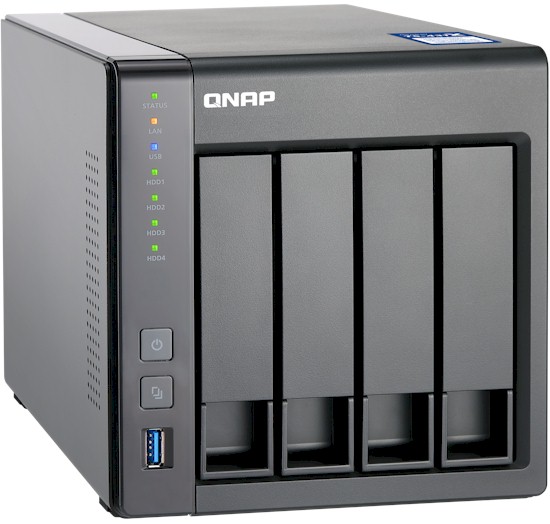
| At a glance | |
|---|---|
| Product | QNAP 10 GbE NAS (TS-431X) [Website] |
| Summary | Four-bay RAID5 class NAS with dual Gigabit Ethernet ports and built-in 10GbE SFP+ port. Powered by dual-core Annapurna Labs CPU. |
| Pros | • Relatively inexpensive for a 10 GbE NAS • Three USB 3.0 ports • Many cloud backup options |
| Cons | • Relatively slow network backup performance |
Typical Price: $478 Buy From Amazon
Introduction
Recent reviews of QNAP products have covered the four-bay TS-431P and its two-bay sibling, the TS-231P. Both of those products are part of QNAP’s “Home-middle range” product lines. The next step above that category is a fairly recent addition by QNAP – the “Entry-level SMB” category. For this review, we’ll be focusing on the TS-431X.
The chart below shows that it’s very similar to the TS-431P, with both using the same Annapurna Labs processor clocked at 1.7 GHz. The two main differences are the amount of memory and the built-in 10 GbE SFP+ port. The TS-431X is available with 2 GB (TS-431X-2G) or 8 GB (TS-431X-8G) of DDR3 RAM vs. a non-expandable 1 GB on the TS-431P. QNAP sent the TS-431X-2G for review.
The chart also includes the QNAP TS-563, which we’ll be using to compare 10 GbE performance. The TS-563-8g (reviewed) has a quad core processor and 8 GB of RAM, compared to the TS-431X’s dual core-processor. So we might expect to see some large performance differences.

QNAP TS-431X comparison
The callouts below show the front and rear panel of the TS-431X. There’s a single USB 3.0 port on the front panel located just below the One Touch Copy button. The rear panel has two Gigabit Ethernet ports, one 10 GbE SFP+ port, and two additional USB 3.0 ports.
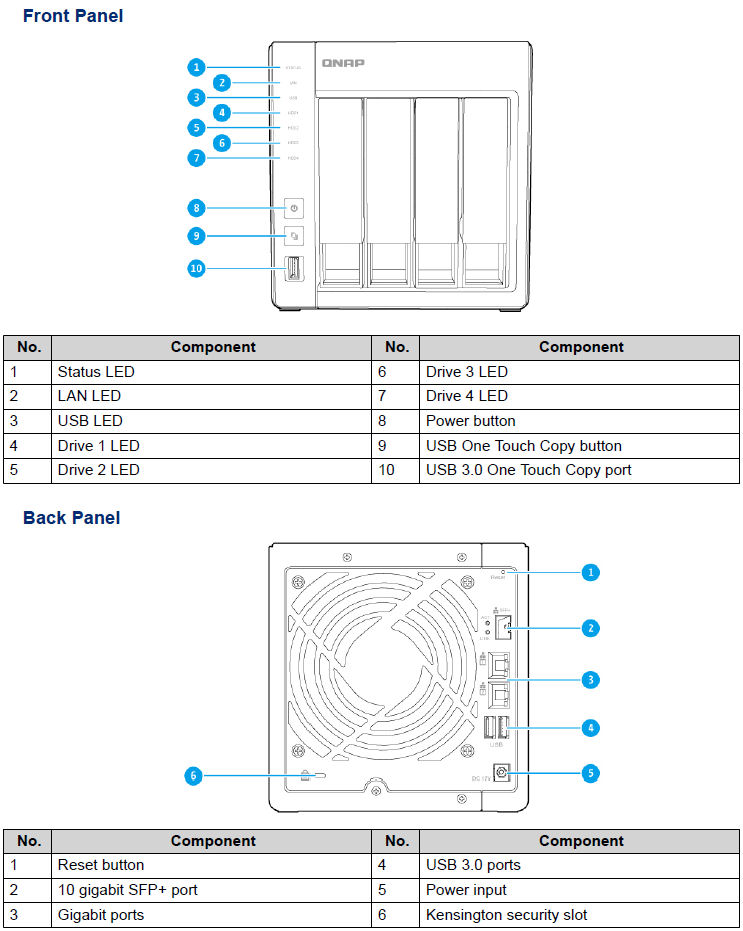
QNAP TS-431X front and rear panel callouts
Inside
The photo below shows the component side of the board. The CPU is covered with a large heat sink. In the lower right corner, there’s a connector for the riser card for the drive backplane.
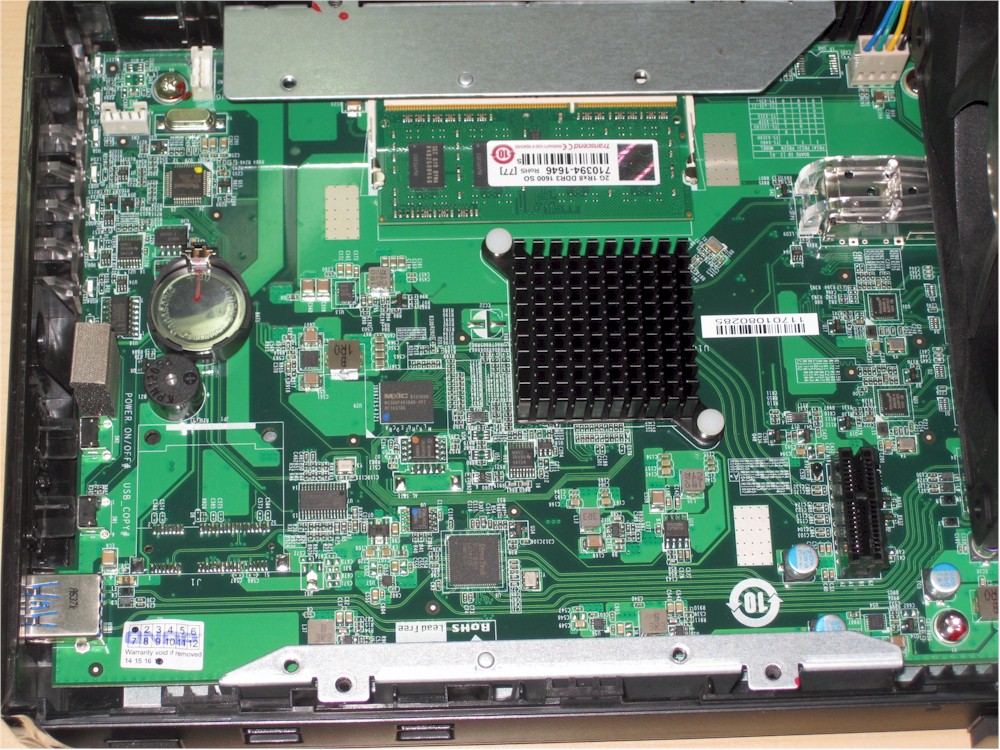
QNAP TS-431X main PCB
The table below summarizes the key components for the TS-431X, TS-431P and TS-563 I’ll be comparing later in the performance section. Note the 10 GbE port connects directly to the AL-212 processor; no 10 GbE PHY was required.
| QNAP TS-431X | QNAP TS-431P | QNAP TS-563-8G | |
|---|---|---|---|
| CPU | Annapurna Labs Alpine AL-212 @ 1.7 GHz dual-core | Annapurna Labs Alpine AL-212 @ 1.7 GHz dual-core | AMD x86 G-Series Quad-core 2.0 GHz processor (GX-420CA) |
| RAM | 2 GB DDR3 Transcend SoDIMM (expandable to 8 GB – 1 slot) | 1 GB DDR3 Micron MT41K256M8DA-125 (x4) | 8 GB DDR3 SoDIMM(upgradeable to 16 GB total) |
| Flash | 512 MB Macronix MX30UF4G18AB | 512 MB Macronix MX30UF4G18AB | 512 MB USB DoM |
| Ethernet | Atheros AR8035A Gigabit Ethernet PHY (x2) | Atheros AR8035A Gigabit Ethernet PHY (x2) | Intel WG1210AT (x2) |
| USB 3.0 | Etron Tech EJ188H USB 3.0 host controller | Etron Tech EJ188H USB 3.0 host controller | Asmedia 1074 4 port USB 3.0 controller |
| SATA | In AL-212 | In AL-212 | Marvell 88SE9215 SATA 6Gb/s Host Controller (x3 on drive backplane) |
Table 1: Key component summary
Power consumption with four SNB-provided WD Red 1TB (WD10EFRX) drives was 22 W (active) and 13 W power save. Fan and drive noise was rated as low (mostly drive noise).![]()
Features
As we pointed out in our review of the TS-431P, QNAP NASes share a common operating system, whose latest version is QTS 4.3. You can read or download a comprehensive brochure here. QTS 4.3 continues QTS 4.2.2’s look and feel with some minor visual tweaks. You still can’t resize many of the windows, whose default width is more than 1024px. The screenshot below shows the “hamburger” menu and dashboard flyouts exposed.
![]()
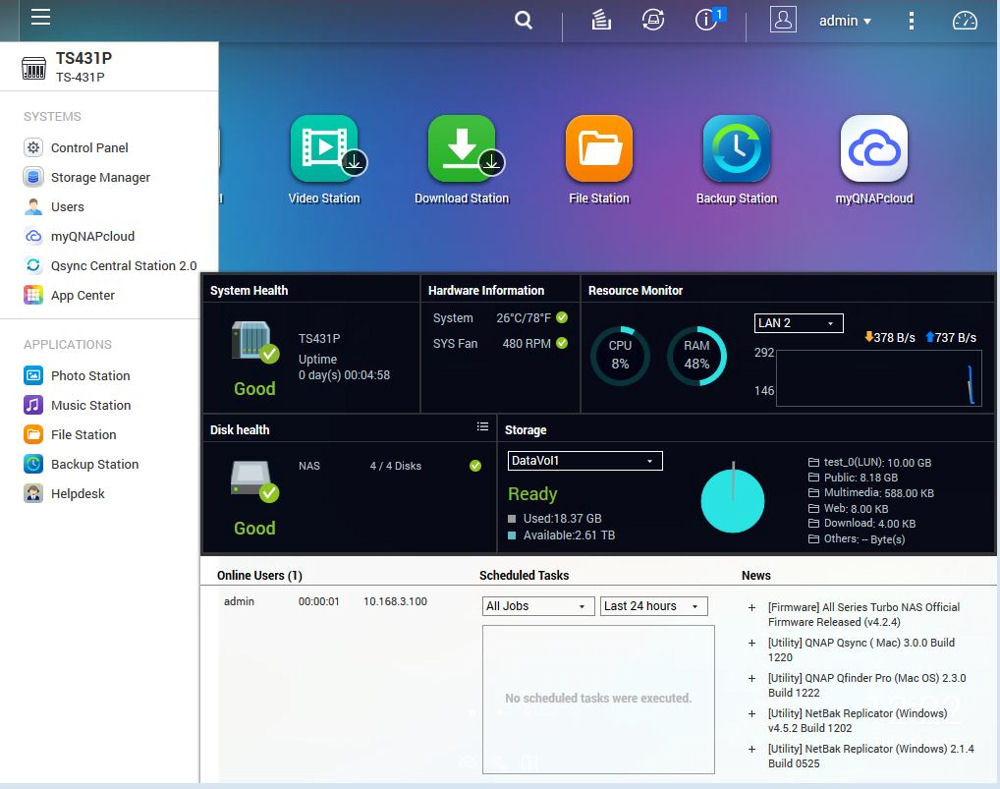
QNAP QTS 4.3 desktop
Performance
Firmware version QTS 4.3.3.0154 was loaded onto the TS-431X and performance tests were run using the Revision 5 NAS test process. All tests were run using Western Digital Red 1 TB (WD10EFRX) (x4 SNB supplied). The Intel X540-T2 card we’ve used for previous 10 GbE review supports 10GBASE-T (copper) connections only. So a 10Gtek x520DAI card was installed in the NAS test bed machine. The same Intel 3.9.58.9101 Windows driver used by the Intel card worked just fine with the 10Gtek. Since the NAS doesn’t ship with a 10 GbE SFP+ cable, we used a Cable Matters 3m SFP+ cable to hook things up.
We’re going to focus on the TS-431X’ 10 GbE performance. As we’ve pointed out in many reviews, most of today’s NASes can saturate a single Gigabit Ethernet connection when transferring large sequential files and the TS-431X is no exception. That’s why the NAS Charts have so many products with 109 / 110 MB/s File Copy results. If you want to break the 1 gigabit barrier, you need to use multiple clients, enable link aggregation on the NAS ports and connect through a switch that also supports link aggregation. Or you need to move to 10 GbE. Although 10 GbE will cost more for both NAS and client, this method supports higher throughput with a single client with no link aggregation required.
To get a feel for how the seven 10 GbE products in our charts compared, I created a chart for 10 GbE RAID 5 File Copy Write and 10 GbE RAID 5 File Copy read. For File Copy Write, the TS-431X-2G was surprisingly just slightly faster than the TS-563-8G. For File Copy Read, the QNAP TS-563-8G outperformed all other NASes by a significant amount, while the TS-431X-2G was the slowest of the batch. Still, 326.9 MB/s is more than three times the throughput achievable with Gigabit Ethernet.
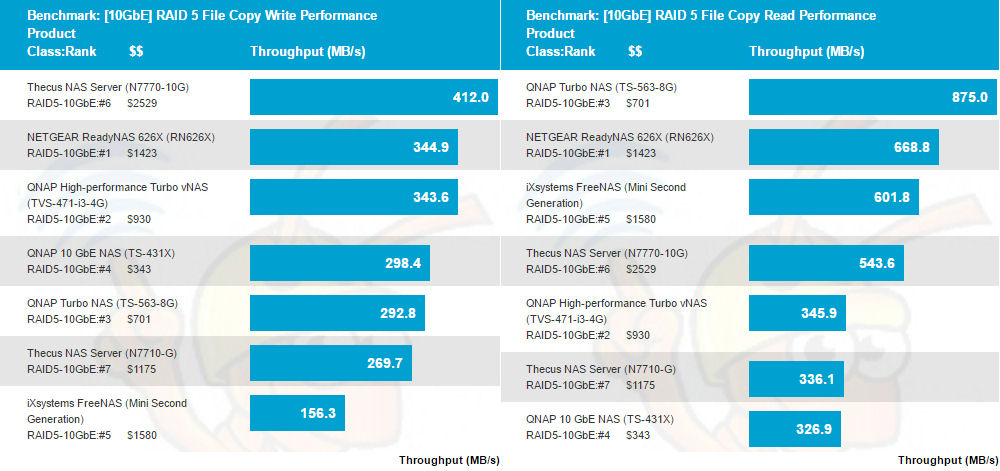
10 GbE RAID 5 File Copy Write and File Copy Read comparisons
The benchmark summary composite chart below shows only the 10 GbE test results run using a single 10 GbE client. If you want to see the complete results including the Gigabit Ethernet tests, you can click here for the TS-431X-2G or here for the TS-563-8G.
Looking at the chart, you can see that for File Copy Write performance, both of the NASes turned in very similar results for all RAID levels. But for File Copy Read, the TS563-8X has the highest throughput we’ve seen. In general, the TS-563-8G outperformed the TS431X-2G with a couple of exceptions. For the RAID 5 10 GbE NASPT File Copy To NAS and File Copy From NAS tests, the TS-431X-2G outperformed the TS-563-8G.

Benchmark Summary Comparison – 10 GbE
Prior to this review, the NAS Ranker did not take into account 10 GbE performance and ranked products only using gigabit benchmarks. The NAS Ranker has now been changed to include 10 GbE benchmarks in the ranking calculation. So we have moved all 10 GbE capable products to a new RAID 5 – 10 GbE class. You can also view sub-ranking for both gigabit and 10 GbE benchmarks. The image below shows the new class and rankings for the NAS Ranker.
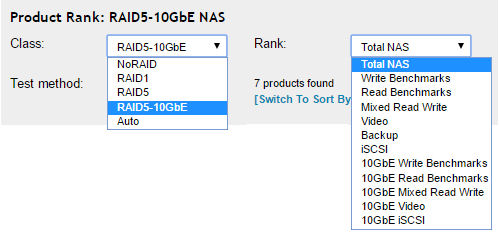
NAS Ranker new 10 GbE class and new ranking categories
So let’s take the NAS Ranker’s new 10 GbE features for a spin. Since there are only seven NASes that have been tested with 10 GbE so far, I decided to leave the results sorted by Rank. The NAS Ranker shows that based on performance, the QNAP TS-431X-2G ranks #4 against some very pricey competition.
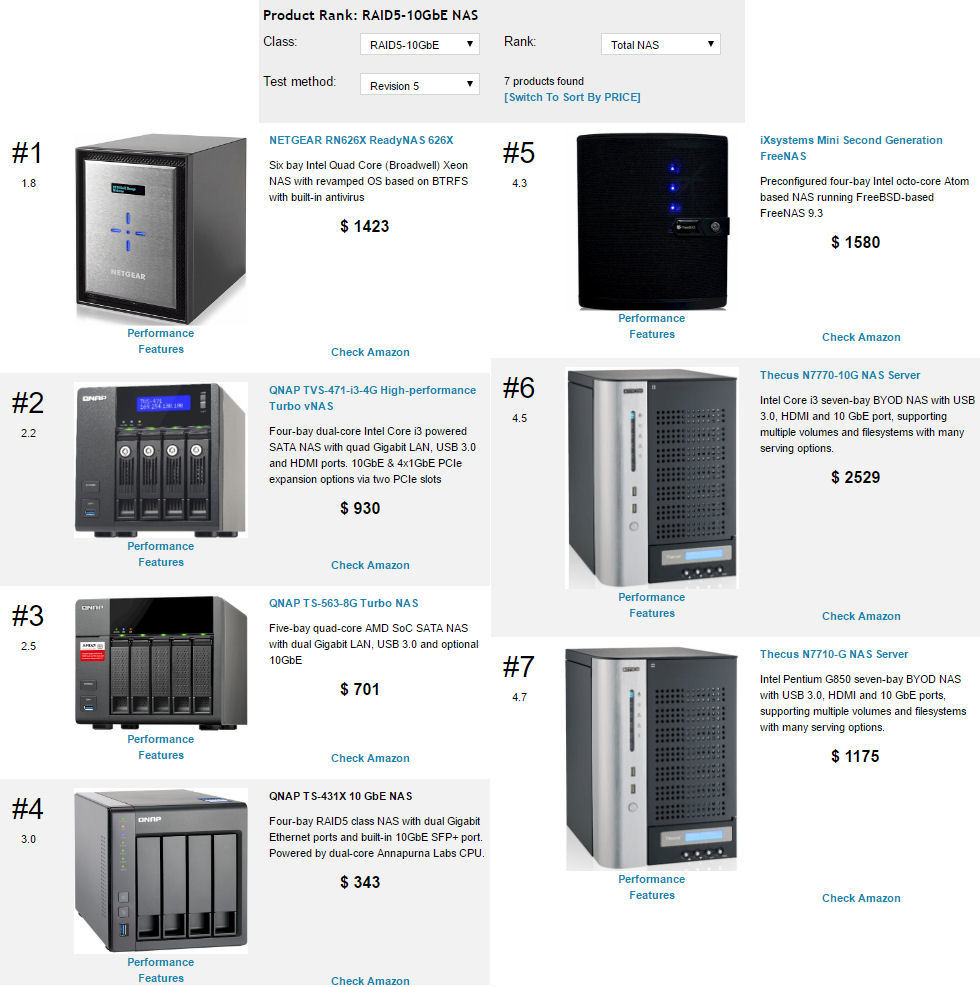
Ranker Performance comparison – 10 GbE
Turning to the Ranker Performance Summary, you’ll find there’s lots of data in the composite chart below. Looking first at the Gigabit Ethernet results near the top of the chart, the TS-431X-2G tied with the TS-563-8G for Read Benchmarks and iSCSI categories, and actually outperformed the TD-563-8G for Mixed Read Write, Video, and backup categories. Just to reiterate, these rankings are only for the seven products currently in the RAID5 – 10 GbE class.
For the 10 GbE category rankings, the TS-563-8G had clear category wins over the TS-431X-2G in the Read Benchmark category (#1 vs #4) and the Mixed Read Write category (#2 vs. #5). For all other categories, the TS-431X-2G ranked only one rank behind the TS-563-8G.
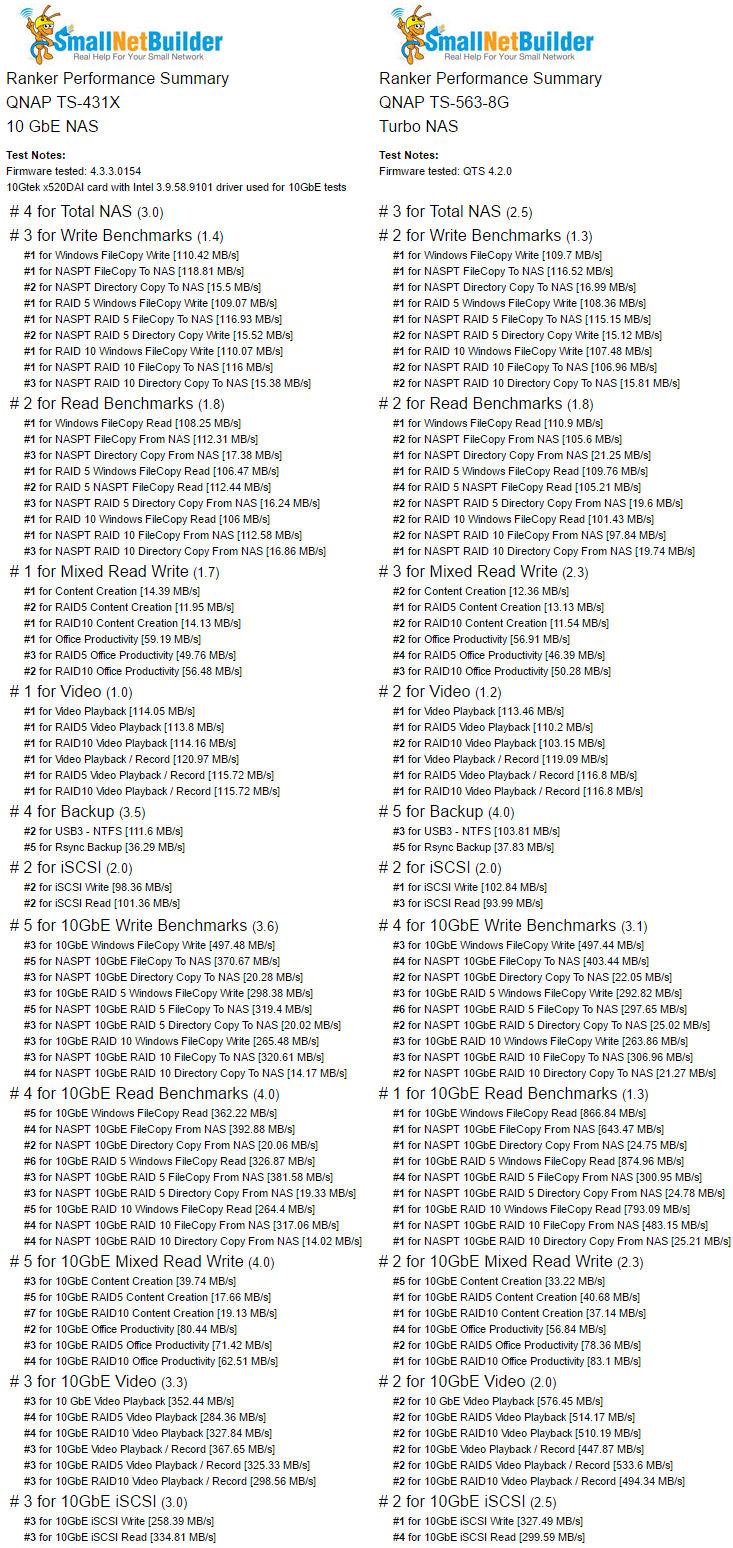
Ranker Performance Comparison – 10 GbE
Closing Thoughts
The TS-431X is an interesting product targeted at the entry level SMB market, yet it offers a significant amount of performance. The built-in 10 GbE SFP+ port offers performance beyond what link-aggregated dual Gigabit NASes can offer. And it gives significantly more expensive 10 GbE-capable NASes a run for their money from a performance perspective. At its current price around $350, it is an incredible value.
The TS-431X is not directly comparable to many much more expensive 10 GbE-tested NASes. It only has four bays and only a single 10 GbE port. The TS-563-8G has five bays, so potentially, you could have more storage capacity than on a four-bay NAS or a live spare. But at around $700, it does not come with built-in 10 GbE port. A single port PCIe 10 GbE SFP+ compatible card will set you back another $170.
Even if you don’t plan to use the TS431X’s 10 GbE capabilities, the TS-431X offers excellent performance as a Gigabit Ethernet NAS, running neck-and-neck with the #5 ranked RAID 5 TS-431P, as well as the #3-ranked Synology DS416. Whether you plan to use 10 GbE, want to future proof by buying a NAS with 10 GbE capabilities, or are just looking for a four-bay value-packed NAS to use on your Gigabit network, the TS-431X-2G would be a difficult NAS to pass up.
